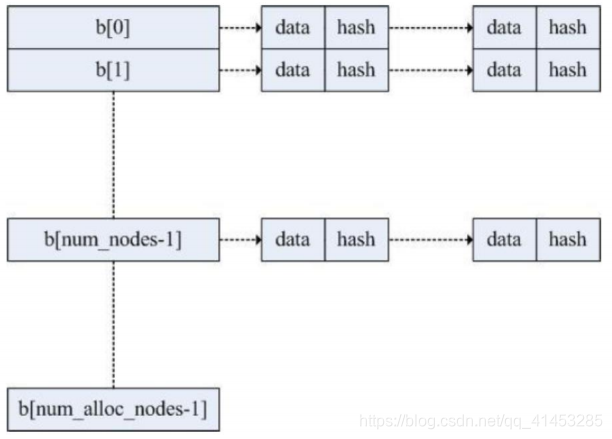一、哈希表
- 在一般的数据结构如线性表和树中,记录在结构中的相对位置是与记录的关键字之间不存在确定的关系,在结构中查找记录时需进行一系列的关键字比较。这一类查找方法建立在 “比较”的基础上,查找的效率与比较次数密切相关。理想的情况是能直接找到需要的记 录,因此必须在记录的存储位置和它的关键字之间建立确定的对应关系,使每个关键字和结构中一个唯一的存储位置相对应。在查找时,只需根据这个对应关系找到给定值。这种对应关系既是哈希函数,按这个思想建立的表为哈希表
- 哈希表存在冲突现象:不同的关键字可能得到同一哈希地址。在建造哈希表时不仅要设定一个好的哈希函数,而且要设定 一种处理冲突的方法
二、OpenSSL哈希表的实现
- OpenSSL也自己实现了一套哈希算法,并能存放任意形式的数据,比如配置文件的读取、内存分配中被分配内存的信息等
- 本文介绍OpenSSL1.1.1g版本的哈希实现,其源码位于OpenSSL源码目录的crypto/lhash目录下

三、哈希表数据结构
- 哈希表数据结构在lhash_local.h中定义。基本的结构如下示图:

struct lhash_node_st(单链表节点)
- 本结构是一个单链表的节点。其中,data用于存放数据地址,next为下一个数据地址,hash为数据哈希计算值
struct lhash_node_st {
void *data;
struct lhash_node_st *next;
unsigned long hash;
};
struct lhash_st(哈希表)
- 其中,b指针数组用于存放所有的数据,数组中的每一个值为数据链表的头指针
- comp用于存放数据比较函数地址
- hash用于存放计算哈希值函数的地址
- num_nodes为链表个数
- num_alloc_nodes为b分配空间的大小
struct lhash_st {
OPENSSL_LH_NODE **b;
OPENSSL_LH_COMPFUNC comp;
OPENSSL_LH_HASHFUNC hash;
unsigned int num_nodes;
unsigned int num_alloc_nodes;
unsigned int p;
unsigned int pmax;
unsigned long up_load; /* load times 256 */
unsigned long down_load; /* load times 256 */
unsigned long num_items;
unsigned long num_expands;
unsigned long num_expand_reallocs;
unsigned long num_contracts;
unsigned long num_contract_reallocs;
TSAN_QUALIFIER unsigned long num_hash_calls;
TSAN_QUALIFIER unsigned long num_comp_calls;
unsigned long num_insert;
unsigned long num_replace;
unsigned long num_delete;
unsigned long num_no_delete;
TSAN_QUALIFIER unsigned long num_retrieve;
TSAN_QUALIFIER unsigned long num_retrieve_miss;
TSAN_QUALIFIER unsigned long num_hash_comps;
int error;
};
四、函数说明
OPENSSL_LH_new()
OPENSSL_LHASH *OPENSSL_LH_new(OPENSSL_LH_HASHFUNC h, OPENSSL_LH_COMPFUNC c);
- 功能:创建哈希表
- 参数:
- 输入参数h为哈希函数
- c为比较函数
- 这两个函数都是回调函数。 因为哈希表用于存放任意的数据结构,哈希表存放、查询、删除等操作都需要比较数据和进行哈希运算,而哈希表不知道用户数据如何进行比较,也不知道用户数据结构中需要对哪些关键项进行散列运算。所以,用户必须提供这两个回调函数
- 返回值:
- 成功返回OPENSSL_LHASH
- 失败返回NULL
OPENSSL_LH_free
void OPENSSL_LH_free(OPENSSL_LHASH *lh);
- 功能:释放哈希表
- 但是不释放表中数据的内存,需要调用下面的doall方法遍历表中数据去释放
OPENSSL_LH_delete
void *OPENSSL_LH_delete(OPENSSL_LHASH *lh, const void *data);
- 功能:删除哈希表中的一个数据节点
- 参数:
- 返回值:
OPENSSL_LH_doall
void OPENSSL_LH_doall(OPENSSL_LHASH *lh, OPENSSL_LH_DOALL_FUNC func);
- 功能:遍历哈希表中的所有数据
- 参数:
- lh:哈希表
- func:为外部提供的回调函数,哈希表中的每个节点会依次传递给func
- 无返回值
OPENSSL_LH_doall_arg
void OPENSSL_LH_doall_arg(OPENSSL_LHASH *lh, OPENSSL_LH_DOALL_FUNCARG func, void *arg);
- 功能:处理哈希表中所有数据
- 参数:
- lh:哈希表
- func:为外部提供的回调函数,哈希表中的每个节点和参数3都会传递给该函数
- arg:作为func回调函数的参数2使用
- 此参数类似于lh_doall 函数,只不过func是为两个参数的
OPENSSL_LH_insert
void *OPENSSL_LH_insert(OPENSSL_LHASH *lh, void *data);
- 功能:往哈希表中添加数据
- 参数:
- lh:哈希表
- data:为需要添加数据结构的指针地址
- 当表中有该数据时,会进行替换
- 返回值:
OPENSSL_LH_retrieve
void *OPENSSL_LH_retrieve(OPENSSL_LHASH *lh, const void *data);
- 功能:查询数据
- 参数:
- lh:哈希表
- data:要查询的数据的地址
- 参数2必须提供关键项(这些关键项对应于用户提供的哈希函数和比较函数)以供查询,比如SSL握手中服务端查询以前存储的SESSION时,它需要提供其中关键的几项:
SSL_SESSION *ret=NULL,data;
data.ssl_version=s->version;
data.session_id_length=len;
memcpy(data.session_id,session_id,len);
ret=(SSL_SESSION *)lh_retrieve(s->ctx->sessions,&data);
OPENSSL_LH_num_items
unsigned long OPENSSL_LH_num_items(const OPENSSL_LHASH *lh);
- 功能: 获取哈希表中元素的个数
- 参数:返回元素的个数
OPENSSL_LH_strhash
unsigned long OPENSSL_LH_strhash(const char *c);
- 功能: 计算一条数据的哈希值
- 参数:
- 参数:返回哈希值
OPENSSL_LH_stats
void OPENSSL_LH_stats(const OPENSSL_LHASH *lh, FILE *fp);
- 功能:打印哈希表的统计信息,此函数调用了lh_stats_bio
- 参数:
- lh:哈希表
- fp:用于保存查询到的内容
OPENSSL_LH_node_stats
void OPENSSL_LH_node_stats(const OPENSSL_LHASH *lh, FILE *fp);
- 功能: 将哈希表中每个链表下数据到个数输出到FILE中。
- 参数:
- lh:哈希表
- fp:用于保存查询到的内容
- 此函数调用了lh_node_stats_bio函数
OPENSSL_LH_node_usage_stats
void OPENSSL_LH_node_usage_stats(const OPENSSL_LHASH *lh, FILE *fp);
- 功能: 查看哈希表节点的使用状态
- 此函数调用了lh_node_usage_stats_bio函数
OPENSSL_LH_stats_bio
void OPENSSL_LH_stats_bio(const OPENSSL_LHASH *lh, BIO *out);
OPENSSL_LH_node_stats_bio
void OPENSSL_LH_node_stats_bio(const OPENSSL_LHASH *lh, BIO *out);
- 功能: 将哈希表中每个链表下的数据状态输出到BIO中
- 参数:
OPENSSL_LH_node_usage_stats_bio
void OPENSSL_LH_node_usage_stats_bio(const OPENSSL_LHASH *lh, BIO *out);
五、编程示例1
代码如下
//hash_test1.c
#include <stdio.h>
#include <string.h>
#include <openssl/lhash.h>
#define NAME_LENGTH 32
typedef struct _Person
{
char name[NAME_LENGTH];
double hight;
} Person;
int personCompare(const void *arg1, const void *arg2)
{
char *name1 = ((Person*)arg1)->name;
char *name2 = ((Person*)arg2)->name;
return strcmp(name1, name2);
}
void printNode(void *arg)
{
Person *person = (Person*)arg;
printf("name :%s, height: %f\n", person->name, person->hight);
}
int main()
{
//1.创建哈希表
OPENSSL_LHASH *_hash = OPENSSL_LH_new(NULL, personCompare);
if(_hash == NULL)
{
printf("OPENSSL_LH_new error\n");
return -1;
}
//2.向哈希表中插入三条数据
Person person1 = {"Tom", 170.5};
Person person2 = {"Joke", 180.5};
Person person3 = {"Alan", 175.5};
OPENSSL_LH_insert(_hash, &person1);
OPENSSL_LH_insert(_hash, &person2);
OPENSSL_LH_insert(_hash, &person3);
//3.遍历所有的数据
OPENSSL_LH_doall(_hash, printNode);
printf("\n\n");
//4.删除一条数据之后再遍历
if(OPENSSL_LH_delete(_hash, (const void*)"Tom") == NULL)
{
printf("OPENSSL_LH_delete error\n");
return -1;
}
OPENSSL_LH_doall(_hash, printNode);
printf("\n\n");
//5.查找一条数据
void *findData = OPENSSL_LH_retrieve(_hash, "Alan");
if(findData == NULL)
{
printf("OPENSSL_LH_retrieve error\n");
return -1;
}
printf("find success:\n\t");
printNode(findData);
//6.销毁哈希表
OPENSSL_LH_free(_hash);
return 0;
}
gcc -o hash_test1 hash_test1.c -lssl -lcrypto

五、编程示例2
代码如下
//hash_test2.c
#include <stdio.h>
#include <string.h>
#include <openssl/lhash.h>
unsigned long hashff(void *hf)
{
printf("%s\n",hf);
return 100;
}
int hashfCmp(int *a,int *b)
{
return *a > *b;
}
void printArg(int *a,char *b)
{
printf("doall_arg: %d %s\n",*a,b);
}
void printValue(int *value)
{
printf("doall: %d\n",*value);
}
int main(int argc, const char * argv[]) {
OPENSSL_LHASH *lh = OPENSSL_LH_new(NULL, NULL);
int item = 1;
OPENSSL_LH_insert(lh, &item);
int item2 = 10;
OPENSSL_LH_insert(lh, &item2);
int item3 = 5;
OPENSSL_LH_insert(lh, &item3);
//因为表中已经存在数据5,如果再插入,将会替换之前的数据5
int item4 = 5;
int *ret=0;
ret = OPENSSL_LH_insert(lh, &item4);
if (*ret==item4) {
printf("insert replace PASS\n");
}
int *fd = 0;
fd = OPENSSL_LH_retrieve(lh,&item2);
if (*fd == item2) {
printf("find value PASS\n");
}
OPENSSL_LH_doall(lh, printValue);
OPENSSL_LH_doall_arg(lh, printArg, "arg");
int *delRet = 0;
delRet = OPENSSL_LH_delete(lh, &item4);
if (*delRet==item4) {
printf("delete value PASS\n");
}
int numLen = OPENSSL_LH_num_items(lh);
printf("len=%d\n");
OPENSSL_LH_stats(lh, stdout);
OPENSSL_LH_free(lh);
return 0;
}
gcc -o hash_test2 hash_test2.c -lssl -lcrypto




